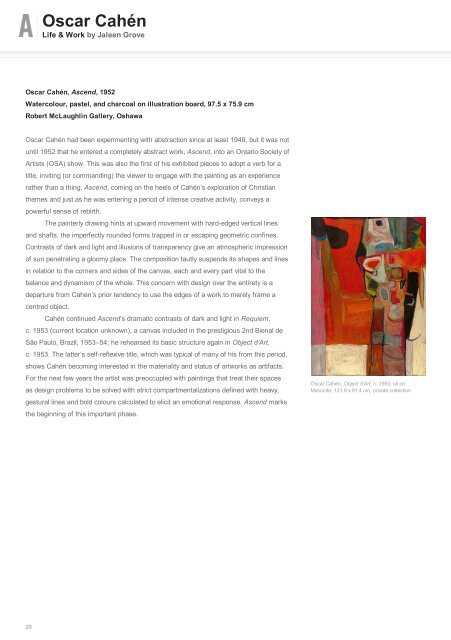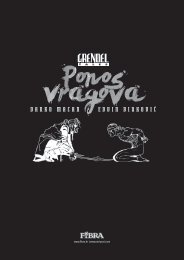Oscar Cahén
Art-Canada-Institute_Oscar-Cah%C3%A9n
Art-Canada-Institute_Oscar-Cah%C3%A9n
Create successful ePaper yourself
Turn your PDF publications into a flip-book with our unique Google optimized e-Paper software.
<strong>Oscar</strong> <strong>Cahén</strong><br />
Life & Work by Jaleen Grove<br />
<strong>Oscar</strong> <strong>Cahén</strong>, Ascend, 1952<br />
Watercolour, pastel, and charcoal on illustration board, 97.5 x 75.9 cm<br />
Robert McLaughlin Gallery, Oshawa<br />
<strong>Oscar</strong> <strong>Cahén</strong> had been experimenting with abstraction since at least 1949, but it was not<br />
until 1952 that he entered a completely abstract work, Ascend, into an Ontario Society of<br />
Artists (OSA) show. This was also the first of his exhibited pieces to adopt a verb for a<br />
title, inviting (or commanding) the viewer to engage with the painting as an experience<br />
rather than a thing. Ascend, coming on the heels of <strong>Cahén</strong>’s exploration of Christian<br />
themes and just as he was entering a period of intense creative activity, conveys a<br />
powerful sense of rebirth.<br />
The painterly drawing hints at upward movement with hard-edged vertical lines<br />
and shafts, the imperfectly rounded forms trapped in or escaping geometric confines.<br />
Contrasts of dark and light and illusions of transparency give an atmospheric impression<br />
of sun penetrating a gloomy place. The composition tautly suspends its shapes and lines<br />
in relation to the corners and sides of the canvas, each and every part vital to the<br />
balance and dynamism of the whole. This concern with design over the entirety is a<br />
departure from <strong>Cahén</strong>’s prior tendency to use the edges of a work to merely frame a<br />
centred object.<br />
<strong>Cahén</strong> continued Ascend’s dramatic contrasts of dark and light in Requiem,<br />
c. 1953 (current location unknown), a canvas included in the prestigious 2nd Bienal de<br />
São Paulo, Brazil, 1953–54; he rehearsed its basic structure again in Object d’Art,<br />
c. 1953. The latter’s self-reflexive title, which was typical of many of his from this period,<br />
shows <strong>Cahén</strong> becoming interested in the materiality and status of artworks as artifacts.<br />
For the next few years the artist was preoccupied with paintings that treat their spaces<br />
as design problems to be solved with strict compartmentalizations defined with heavy,<br />
gestural lines and bold colours calculated to elicit an emotional response. Ascend marks<br />
the beginning of this important phase.<br />
<strong>Oscar</strong> <strong>Cahén</strong>, Object d’Art, c. 1953, oil on<br />
Masonite, 121.9 x 91.4 cm, private collection<br />
Growing Form 1953<br />
28



